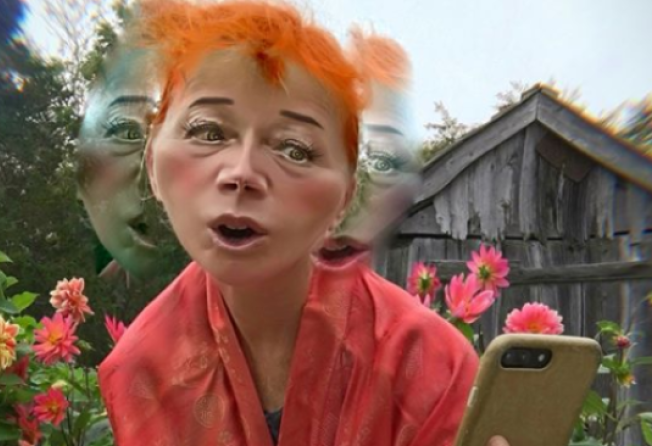How Instagram became artists’ creative playground – from Damien Hirst’s dissections to Cindy Sherman’s selfies
It would cost thousands of dollars to gain such intimate access to creatives such as Ai Weiwei, but now it’s just a click away. The social media app has opened new channels for artists to share their work and the process behind it

“Got my blonde on,” writes photographer Cindy Sherman in a recent Instagram post. In the photo, a woman with a blond wig and a computer-generated symphony of neck wrinkles, faces down the viewer. “Looks like some women I saw at Mar-a-Lago,” reads one comment, referring to the Donald Trump-owned luxury resort in Florida.
Sherman seems to have tapped into the Trump era’s gaudy glitz and glares. But there’s more to this. “Yeah and?” the surly tilt of her head seems to be saying, even if her eyes – poised between vulnerability and defiance like so many Sherman-created women – tell a different story.
It’s odd that it took Sherman so long to put her work on Instagram. For decades, she was doing Instagram before Instagram. From Untitled Film Stills (1977-80) onwards, her art has dealt with all the stuff that captivates and disgusts about the photo-sharing site: the narcissism, the perils and pleasures of self-exhibition, the cunningly filtered fantasies masquerading as the real thing.
Not all Sherman’s posts depict her as different women in delirious costumes and bonkers make-up.
And not all are the result of her playing about with Facetune, an app that allows her to reshape heads and eliminate wrinkles, or Perfect365, the make-up simulator she uses to give her subjects garish digital makeovers.
A post shared by cindy sherman (@cindysherman) on Oct 20, 2017 at 3:28am PDT
There are holiday snaps of lighthouses, Mick and Keith bumping and grinding at a Rolling Stones gig. But even the dullest moments of Sherman’s Instagram are incidentally fascinating since they reveal the woman of 1,000 disguises letting her mask slip. She goes to Katy Perry gigs? She gets inspiration from a Dior show? Her Instagram “besties” include Sex and the City siren Kim Cattrall? Cindy, we hardly knew you!
But here’s the twist: because we’re looking at an artist’s Instagram, rather than our friend’s, the everyday is transfigured. Just as Marcel Duchamp put a urinal in a gallery and called it art, so Sherman can put her day-to-day life alongside her art on Instagram and invite us to contemplate the mundane in a new setting.
A post shared by Damien Hirst (@damienhirst) on Jan 19, 2018 at 8:02am PST
Elsewhere, astute artists are using Instagram to connect with their fan base in new ways.
Earlier this year, it became clear that Damien Hirst’s people were no longer writing his Instagram posts, but rather the artist was. Suddenly it became worth following – Hirst was disarmingly explaining how he got the diamonds for his skull, why he was wrong about minimalism, and how sausages are “stupid”. I’m also enjoying Ai Weiwei’s posts for their captivating capacity for selfie mockery but mostly for his dystopian shots of rotting veg. Why he’s posting jade-glazed doughnuts, though, is beyond me.
A post shared by Ai Weiwei (@aiww) on Apr 2, 2018 at 3:50pm PDT
Richard Prince, meanwhile, has found another way to exploit Instagram. The American artist exhibited 38 paintings of screenshots of other people’s Instagram photos at the Gagosian gallery in New York, in 2014. He sold the results for up to US$100,000, without crediting their original creators. Some critics called his work “genius trolling”, but that didn’t wash with one appropriated photographer, Donald Graham, who is now suing Prince.
The case is ongoing but Graham has posted a photo of works in Prince’s show with the comment: “The only way you’d know my work was a part of this display is … well, that’s just it, you wouldn’t know.”
Another Instagram image Prince appropriated was a selfie of Ivanka Trump getting her hair and make-up done for a photo shoot. He printed the image onto canvas and sold it to Ivanka for US$36,000. She proudly posed in front of the print – thus creating that abomination of narcissism, a selfie of a selfie, and posted that on Instagram.
A post shared by Ivanka Trump (@ivankatrump) on Jan 14, 2015 at 9:05am PST
And then something very odd happened. Prince returned the US$36,000 to Ivanka and posted the following on Twitter: “This is not my work. I did not make it. I deny. I denounce. This fake art.” A nice satirical touch. But, with all due respect, Prince missed a trick. What he should have done is to keep the US$36,000 and painted another picture, this time of the screengrab of Ivanka’s Instagram post of her selfie of her standing in front of his painting of her selfie. And then he could have sold that painting to her. And then – well, the process could have gone on forever.
In our era of post-truths and fake news, Prince’s Instagram appropriations seem as on trend as Cindy Sherman’s new image-dramas of self-presentation. But while she puts her art on Instagram, he makes his by plundering it. Either way, it’s becoming artists’ favourite social media app. Adolescents need Snapchat, media drones must have Twitter, musical.ly is for miming schoolgirls, and LinkedIn a Mecca for middle managers – but increasingly, Instagram is where the art world plays.